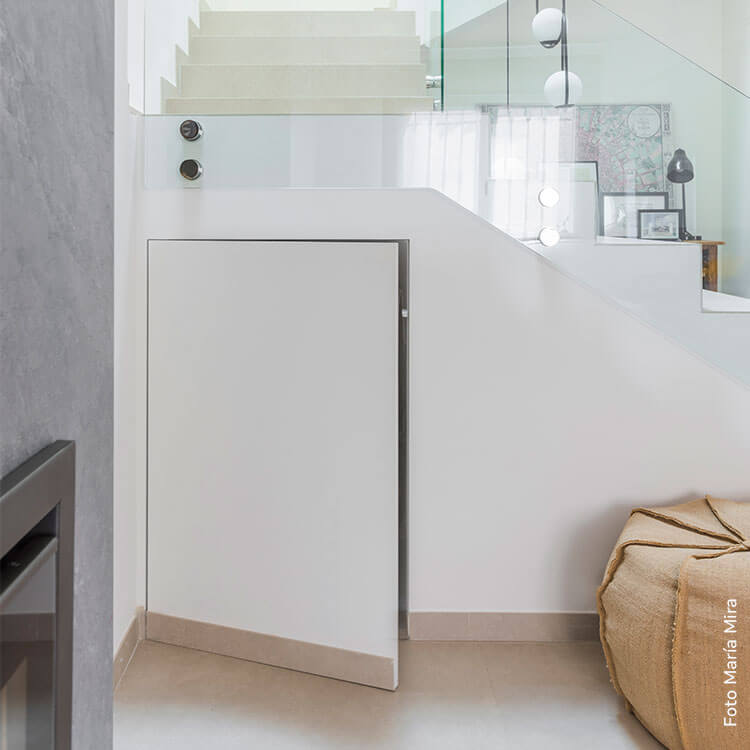HIDDEN DOORS
The hidden doors have revolutionized interior design, offering an aesthetic and functional solution when integrating doors into walls. This concept combines design and advanced technology to adapt to the most demanding projects.
This type of door, also known as invisible doors or camouflaged doors, is characterized by its design without visible mouldings or jambs. Thanks to this feature, they blend elegantly with their surroundings and allow impeccable visual continuity.
Additionally, when referring to floor to ceiling doors, their structure can reach up to 3500 mm in height and can be customized with a wide variety of materials and finishes.

As contemporary architecture evolves towards more open and fluid concepts, hidden wall doors have become an essential choice. They eliminate unnecessary elements and transform the perception of space, making it appear larger and more organized.
Additionally, these doors adapt to a wide variety of styles, materials, and opening systems, making them a valid option for both homes and offices.
Hidden frame doors
The hidden frame system is one of the pillars of invisible doors. This design removes moldings and casings, leaving only a uniform surface that aligns perfectly with the wall. Hidden frame doors enhance aesthetics and facilitate customization of finishes, allowing the door to either blend unnoticed or become a decorative element depending on the project.
The frame, manufactured with 6063 aluminum alloy, ensures strength and durability, enduring up to 200,000 opening and closing cycles. Additionally, it is delivered with a phosphating primer that facilitates painting during the final stages of construction.
This type of installation requires precision, but the final result is unmatched in terms of design and functionality. To guarantee a flawless finish, it is essential to have specialized professionals for installation.
Invisible doors
Invisible doors are very popular in interior design projects where continuity and visual cleanliness are fundamental. By fully integrating with the walls, they eliminate visual interruptions and provide a sense of order and spaciousness.
Depending on the material and finish, these doors can be lacquered, wood, or even glass. Each option offers a unique aesthetic, adapting to different decoration styles. For example, the frameless wooden doors are perfect for achieving a balance between modernity and warmth, while glass doors add lightness and luminosity.
The door leaf, made with a clean pine frame and high-density porexpam filling, achieves the perfect balance between strength and lightness. This design is intended to provide superior performance, even in large doors.
Finishes of invisible doors
The choice of finish is fundamental to ensure that the flush doors integrate harmoniously with the space. Sensem offers a wide variety of options, including:
Wood
The invisible wooden doors offer a perfect combination of modern design and natural warmth. This material is highly customizable, allowing choices among different shades and textures that adapt to the overall decor.
Lacquered
For an elegant and ultra-modern finish, the lacquered invisible doors are an excellent option. Available in matte or glossy finishes in any color from the RAL chart, they bring sophistication and perfectly integrate into minimalist spaces.
Glass
Glass is ideal for maximizing natural light. The camouflaged glass doors are an avant-garde choice, offering functionality and contemporary style to any space.
Types of hidden doors according to their location
Hidden doors offer specific solutions for various needs within a space, adapting to both functional and aesthetic uses. Depending on their location, they optimize design and functionality by integrating storage, connecting environments, or maintaining visual continuity.
Hidden wardrobe doors
The hidden wardrobe doors are a practical and aesthetic solution that hides storage areas without compromising the space’s design. They are suitable for bedrooms, living rooms, or dressing rooms where maintaining a clean aesthetic is a priority.
Hidden passage doors
The hidden passage doors are perfect for connecting different areas of a home or office, eliminating visual barriers. Without moldings or jambs, they blend perfectly into any environment, creating a continuous and fluid design.
Types of frameless doors according to their opening system
The opening system is a decisive factor in the functionality and design of frameless doors. Each type of opening adapts to specific needs, from saving space to simply standing out for innovation, integrating perfectly into interior design projects.
Invisible sliding doors
The sliding doors are an ideal solution for spaces where saving space is essential. Sliding instead of opening outward, these doors do not require an opening area, making them perfect for small rooms or narrow corridors.
Frameless hinged doors
The hinged doors are a classic option reinvented by this minimalist design. With hidden hinges, these doors offer traditional opening with modern, functional aesthetics.
Invisible pivot doors
The pivot doors are an elegant and technical alternative. Their opening system, based on hinges installed on the floor and ceiling, allows fluid movement and perfect integration with the space’s design.
Doors with hidden hinges
The hidden hinges are an essential element in the design of invisible doors. This type of hinge eliminates any visible component, contributing to the door’s clean, uniform appearance. Additionally, they ensure smooth and silent movement, enhancing user experience.
Invisible doors prices
The cost of the invisible doors varies depending on the material, opening system, and installation. For example, the wooden camouflaged doors usually have a higher price due to the quality of the material, while other options such as lacquered ones offer a modern aesthetic at a more affordable cost.
Prices range between €560 for basic models and €2,690 for larger doors with customized finishes.

